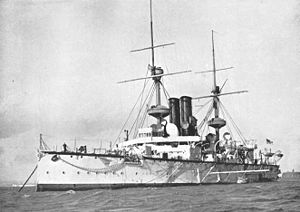Centurion-class battleship

HMS Centurion
|
|
| Class overview | |
|---|---|
| Name: | Centurion-class battleship |
| Builders: | Chatham Dockyard, Portsmouth Dockyard, Pembroke Dockyard |
| Preceded by: | Royal Sovereign class |
| Succeeded by: | HMS Renown |
| Built: | 1890–97 |
| In commission: | 1894–1913 |
| Completed: | 2 |
| Scrapped: | 2 |
| General characteristics (as built) | |
| Type: | Pre-dreadnought battleship |
| Displacement: | 10,500 tons |
| Length: | 360 ft (109.7 m) (between perpendiculars) |
| Beam: | 70 ft (21.3 m) |
| Draught: | 25 ft 6 in (7.8 m) |
| Speed: | 17 knots (31 km/h; 20 mph) (natural draft), 18.5 knots (34.3 km/h; 21.3 mph) (forced draft) |
| Endurance: | 6,000 nmi (11,000 km) at 10 kn (19 km/h) |
| Complement: | 620 |
| Armament: |
|
| Armour: | |
The Centurion-class battleships were second-class pre-dreadnought battleships built for the Royal Navy in the 1890s. They were designed for service on distant stations.
The Centurion class comprised two ships, Centurion and Barfleur. The ships were designed by Sir William White to be lightly armed battleships designed for service on the China Station and Pacific Station. Their relative lack of firepower enabled greater quantities of coal to be carried, extending their range, and it was not thought they would face the big guns of an enemy fleet. They were too lightly armed to slug it out with enemy battleships, but they could outrun them, and they were more than capable of dealing with armored cruisers that they were far more likely to meet on distant stations.
They were considered good steamers and good seaboats, although the use of forced draft was discontinued because it damaged their boilers. Their draughts were designed to be shallow enough to allow passage through the Suez Canal and the navigation of rivers in China. Their hulls were sheathed with wood and copper to reduce fouling and hence allow them to sail longer between docking.
The ships were armed with four 10 inch (254 mm) guns in two barbettes covered by open-backed armored hoods and capable of all-around loading, a secondary armament of ten 4.7 inch (120 mm) guns, numerous smaller guns, and seven torpedo tubes. The previous Royal Sovereign-class battleships had allowed a comparison between high-freeboard ships with their main guns in open barbettes and low-freeboard ships equipped with old-style, heavy, circular turrets and had proven the superiority of the former in the rough waters of the Atlantic; the Centurions were the first barbette-type battleships with armored hoods over their barbettes, giving rise to the armored gunhouses that would be mounted on later ships and which themselves would come to be known as "turrets."
...
Wikipedia
